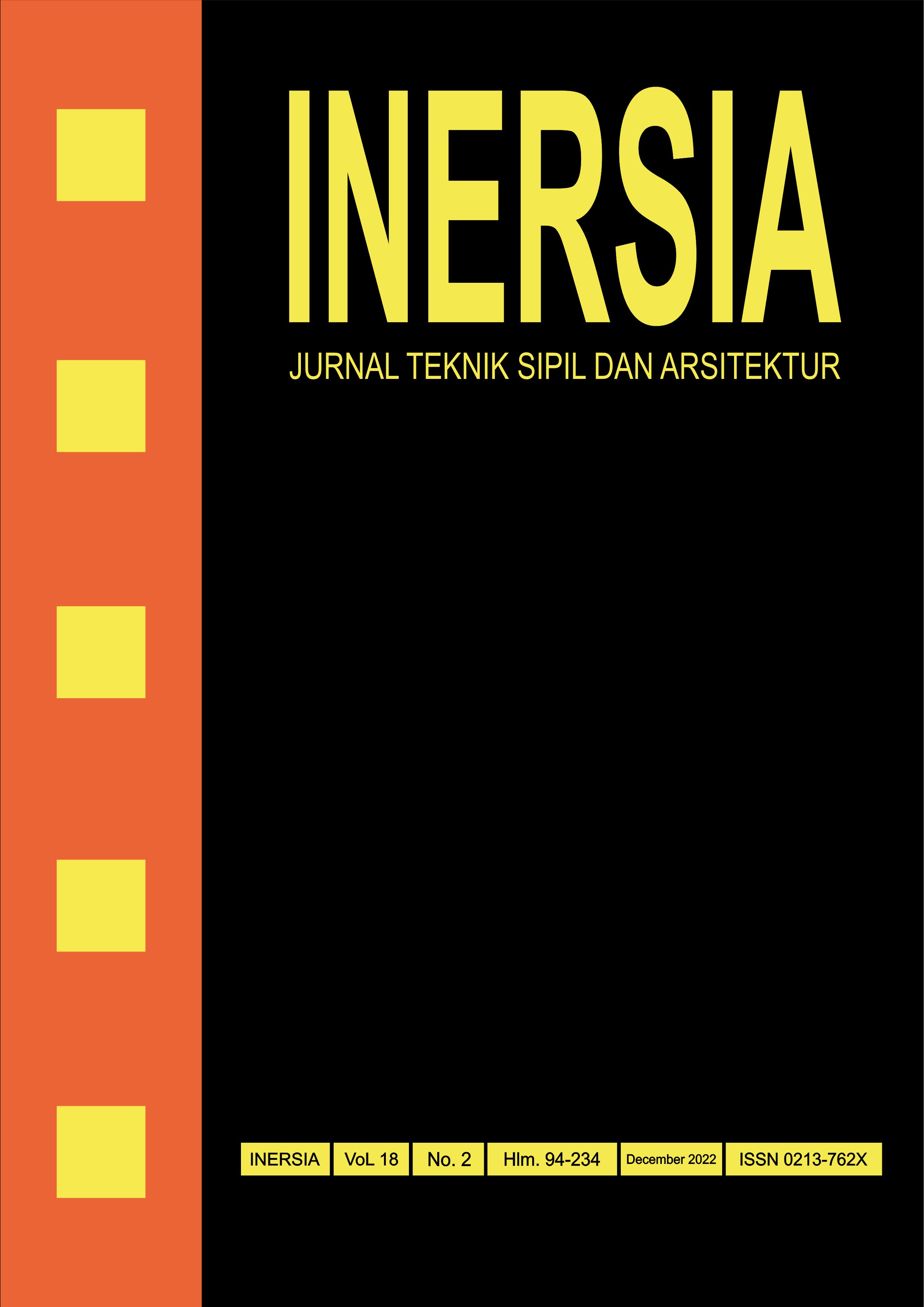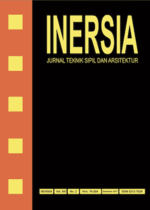The Optimum Vibration of the Compressive Strength of Concrete Specimen
DOI:
https://doi.org/10.21831/inersia.v18i2.54522Keywords:
Compressive Strength, Concrete Vibration, Vibrating TableAbstract
Concrete is the primary material in construction, so it needs further research to get good quality concrete. The quality and durability of concrete are influenced by the amount and shape of the air cavity inside the concrete. With vibrating, the air that is inside the concrete will be lost. The benefits of vibration will only be achieved if planned and implemented with a suitable method. With proper vibration, the air in the concrete will come out and make porous concrete. Reduction or removal of air cavities will make concrete mixes strong with low permeability, increasing the durability of concrete. This study aims to determine the optimum strong vibrating on the compressive strength of Fc' 21,7 Mpa concrete. Vibrating will be performed on cylinder concrete samples with a duration time of 3 minutes and with different variations in acceleration 160 m/s2, 170 m/s2, 180 m/s2, 190 m/s2, 200 m/s2, variation velocity 140 mm/s, 150 mm/s, 160 mm/s, 170 mm/s, 180 mm/s, displacement variation 600 mm, 800 mm, 1000 mm, 1200 mm, 1500 mm. Each variation consists of 7 concrete samples. These tests were performed with methods of external vibrating by using MBT Vibrating table CO-410 in fresh concrete. Compressive strength testing is carried out at 28 days. This study shows that the optimum strong vibrating with acceleration 180 m/s2, velocity 160 mm/s, and displacement 1000 mm with the resulting compressive strength is Fc' 23.06 MPa. So that knowing the optimum vibration strength can be the basis for the implementation of vibration to get the planned concrete quality.References
Z. M. Jaini et al., "Structural behavior of short-span reinforced concrete beams with foamed concrete infill," ARPN J. Eng. Appl. Sci., vol. 11, no. 16, pp. 9820–9825, 2016.
K. P. Fattah, A. K. Al-Tamimi, W. Hamweyah, and F. Iqbal, "Evaluation of sustainable concrete produced with desalinated reject brine," Int. J. Sustain. Built Environ., vol. 6, no. 1, pp. 183–190, 2017, doi: 10.1016/j.ijsbe.2017.02.004.
C. K. Y. Leung, "Concrete as a Building Material," Encycl. Mater. Sci. Technol., pp. 1471–1479, 2001, doi: 10.1016/b0-08-043152-6/00267-9.
M. G. Musbah, A. Musbah, A. Allam, and H. A. Saleh, "Effects of Superplasticizing Admixtures on the Compressive Strength of Concrete," Univers. J. Eng. Sci., vol. 7, no. 2, pp. 39–45, 2019, doi: 10.13189/ujes.2019.070203.
N. M. Sudarshan and T. C. Rao, "Vibration Impact on Fresh Concrete of Conventional and UHPFRC," Int. J. Appl. Eng. Res., vol. 12, no. 8, pp. 1683–1690, 2017.
F. Ma'Arif, Z. Gao, and F. Li, "A Review of the Discrete Element Method Application on Concrete Materials," J. Phys. Conf. Ser., vol. 1625, no. 1, 2020, doi: 10.1088/1742-6596/1625/1/012009.
F. Ma'Arif, Z. Gao, and F. Li, "Investigation of concrete quality using Discrete Element Method (DEM)," J. Phys. Conf. Ser., vol. 1833, no. 1, 2021, doi: 10.1088/1742-6596/1833/1/012053.
J. Gong, Y. Yu, R. Krishnamoorthy, and A. Roda, "Real-time tracking of concrete vibration effort for intelligent concrete consolidation," Autom. Constr., vol. 54, pp. 12–24, 2015, doi: 10.1016/j.autcon.2015.03.017.
M. A. A. Abd Elaty and M. F. Ghazy, "Evaluation of consistency properties of freshly mixed concrete by cone penetration test," HBRC J., vol. 12, no. 1, pp. 1–12, 2014, doi: 10.1016/j.hbrcj.2014.09.001.
J. A. Koch, D. I. Castaneda, R. H. Ewoldt, and D. A. Lange, "Vibration of fresh concrete understood through the paradigm of granular physics," Cem. Concr. Res., vol. 115, pp. 31–42, 2019, doi: 10.1016/j.cemconres.2018.09.005.
X. Gao, J. Zhang, and Y. Su, "Influence of vibration-induced segregation on mechanical property and chloride ion permeability of concrete with variable rheological performance," Constr. Build. Mater., vol. 194, pp. 32–41, 2019, doi: 10.1016/j.conbuildmat.2018.11.019.
S. S. H B Koh, DYeoh, "Effect of re-vibration on the compressive strength and surface hardness of concrete," Mater. Sci. Eng., vol. 271, pp. 1–6, 2017, doi: 10.1088/1757-899X/271/1/012057.
R. Howes, M. N. S. Hadi, and W. South, "Concrete strength reduction due to over compaction," Constr. Build. Mater., vol. 197, pp. 725–733, 2019, doi: 10.1016/j.conbuildmat.2018.11.234.
G. Xiong et al., "Preparation of high strength lightweight aggregate concrete with the vibration mixing process," Constr. Build. Mater., vol. 229, p. 116936, 2019, doi: 10.1016/j.conbuildmat.2019.116936.
J. Zhang, X. Gao, and L. Yu, "Improvement of viscosity-modifying agents on air-void system of vibrated concrete," Constr. Build. Mater., vol. 239, p. 117843, 2020, doi: 10.1016/j.conbuildmat.2019.117843.
M. S. M. D. Zainorizuan Mohd Jaini, Rahmat Hidayat Mohammed Rum, Nor Hayati Abd Ghaffar, Mohammad Shahrul Aizat Misbah, "Experimental study on the vibration responses and energy dissipation of foamed concrete composite slabs," Malaysian Constr. Res. J., vol. 4, no. 2, pp. 193–207, 2018.
Z. Tian et al., "Development of real-time visual monitoring system for vibration effects on fresh concrete," Autom. Constr., vol. 98, pp. 61–71, 2019, doi: 10.1016/j.autcon.2018.11.025.
A. J. Tenza-Abril, D. Benavente, C. Pla, F. Baeza-Brotons, J. Valdes-Abellan, and A. M. Solak, "Statistical and experimental study for determining the influence of the segregation phenomenon on physical and mechanical properties of lightweight concrete," Constr. Build. Mater., vol. 238, pp. 1–12, 2020, doi: 10.1016/j.conbuildmat.2019.117642.
I. Navarrete and M. Lopez, "Estimating the segregation of concrete based on mixture design and vibratory energy," Constr. Build. Mater., vol. 122, pp. 384–390, 2016, doi: 10.1016/j.conbuildmat.2016.06.066.
D. Banerjee, "Determination of compressive strength parameter of high strength silica fume concrete," Int. Res. J. Eng. Technol., vol. 4, no. 4, pp. 2869–2873, 2017.
S. H. Shigeyuki Datea, Yuji Goryozonoa, "Study on Consolidation of Concrete with Vibration," Phys. Procedia, vol. 25, pp. 325–332, 2012, doi: 10.1016/j.phpro.2012.03.091.
Ralph O. Lane, "Behavior of Fresh Concrete During Vibration," Man. Concr. Pract., pp. 1–19, 1998.
I. A. Rahman and M. A. Rahman, "Effect of Vibrations on Concrete Strength," 2007. "Guide to External Vibration."
C. Huang, S. Lin, C. Chang, and H. Chen, "Mix proportions and mechanical properties of concrete containing very high-volume of Class F fly ash q," Constr. Build. Mater., vol. 46, pp. 71–78, 2013, doi: 10.1016/j.conbuildmat.2013.04.016.
ASTM C 150, "Standard Specification for Portland Cement1," p. 515, 2012.
ASTM C33, "Standard Specification for Concrete Aggregates," ASTM Int., vol. i, no. C, p. 11, 2003, doi: 10.1520/C0033.
V. O. Okonkwo and A. E. E, "A Study of the Effect of Aggregate Proportioning On Concrete Properties," Am. J. Eng. Res. ( AJER ), vol. 7, no. 4, pp. 61–67, 2018.
A. Ueno and Y. Ogawa, "Influence of coarse aggregate shape on optimum fine to total aggregate ratio using a virtual voids-ratio diagram in concrete compaction," Cem. Concr. Compos., vol. 106, p. 103463, 2020, doi: 10.1016/j.cemconcomp.2019.103463.
M. I. Safawi, I. Iwaki, and T. Miura, "A study on the applicability of vibration in fresh high fluidity concrete," Cem. Concr. Res., vol. 35, no. 9, pp. 1834–1845, 2005, doi: 10.1016/j.cemconres.2004.10.031.
S. Kamaruddin, W. I. Goh, A. A. Jhatial, S. S. Mohd Zuki, and A. Faiz, "Self-Compacting concrete with incorporation of recycled concrete aggregates," Int. J. Integr. Eng., vol. 11, no. 9, pp. 164–173, 2019.
M. Nematzadeh and M. Naghipour, "Compressing fresh concrete technique and the effect of excess water content on physical-mechanical properties of compressed concrete," Mater. Des., vol. 37, pp. 256–267, 2012, doi: 10.1016/j.matdes.2011.12.051.
ASTM C 31, "Standart pratice making and curing concrete test specimens in the field." .
F. Ma'Arif, Z. Gao, and F. Li, "The Modelling of Compressive Strength of Concrete on Discrete Element Method," J. Phys. Conf. Ser., vol. 1845, no. 1, 2021, doi: 10.1088/1742-6596/1845/1/012079.
K. Aztekin, "The Design , Analysis , and Manufacturing of Vibrating Table," vol. 5, no. 4, pp. 35–42, 2019, doi: 10.7176/JSTR/5-4-05.
F. Ma'arif, I. Yasin, and Z. F. Haza, "Studi Eksperimen Non-Destructive Test dengan Metode Semi-Direct pada Beton," Inersia, vol. 18, no. 1, pp. 44–53, 2022, doi: 10.21831/inersia.v18i1.49118
ASTM C 39, "Compressive Strength of Cylindrical Concrete Specimens," ASTM Stand., pp. 1–7, 2015, doi: 10.1520/C0039
Downloads
Published
How to Cite
Issue
Section
License
Authors who publish with INERSIA journal agree to the following terms:
- Authors retain copyright and grant the INERSIA journal right of first publication with the work simultaneously licensed under Creative Commons Attribution License (CC BY 4.0) that allows others to share the work with an acknowledgment of the work's authorship and initial publication in this journal.
- Authors can enter into separate, additional contractual arrangements for the non-exclusive distribution of the published version of the work (e.g., post it to an institutional repository or edit it in a book), with an acknowledgment of its initial publication in this journal.
- Authors are permitted and encouraged to post their work online (e.g., in institutional repositories or on their website) before and during the submission process, as it can lead to productive exchanges, as well as earlier and greater citation of published work.

INERSIA by https://journal.uny.ac.id/index.php/inersia was distributed under a Creative Commons Attribution 4.0 International License











